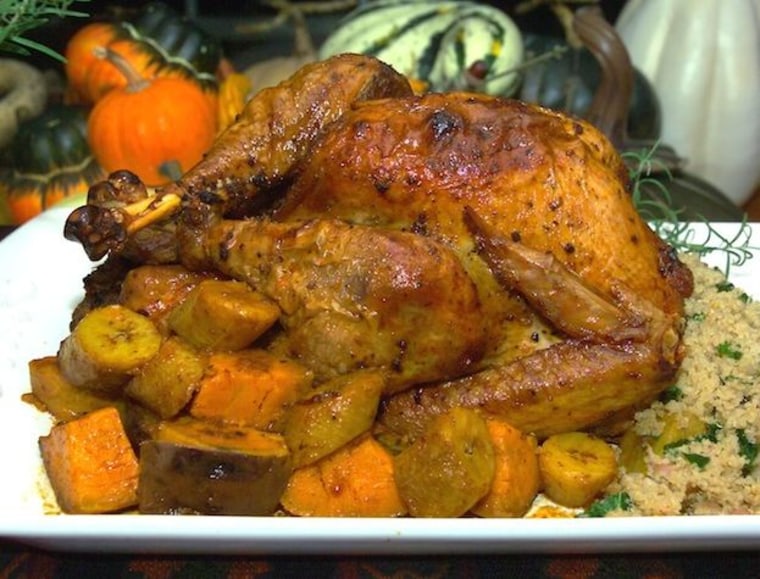Maricel Presilla is a James Beard Award-winning chef and the author of various cookbooks, including the recently-released "Gran Cocina Latina," with more than 500 recipes from throughout Latin America.
By Maricel Presilla, NBC Latino
My first Thanksgiving dinner in the United States was in 1970; my family had been in Miami only four months, staying with relatives. I was in no mood to celebrate. The pain of leaving behind my beloved aunts, grandmother, and boyfriend was compounded by the seeming unfriendliness of our new neighborhood. Still, the golden turkeys of television commercials and magazine ads beckoned, reminding me of our traditional New Year’s feasts back in Cuba. More poignantly, the story of the Pilgrims began to resonate in my mind as a symbol of hope in the face of our own tribulations.
Like most newcomers to this country, we turned Thanksgiving into a hybrid feast. Accustomed to selecting a muscular turkey from our own backyard flock, we succumbed to the easy charm of a plump-breasted Butterball turkey from the supermarket, which we dutifully defrosted and marinated Cuban style with plenty of garlic and bitter orange juice. Instead of braising the turkey in a large cauldron, as we had often done back home, we roasted it in the oven. We served it with congrí, the rice and red kidney bean dish traditional to Santiago de Cuba, plus canned yams and cranberry sauce — concessions to what we considered true Thanksgiving fare that also satisfied our Cuban penchant for mixing sweet and sour flavors.
Teary-eyed, we toasted our good fortune and those we had left behind with Spanish cider, a Cuban Christmas tradition. I felt a surge of gratitude for the roof over my head, and for the first time since our arrival, I lightened up with a real sense of optimism. That same night, as we cleared the table, we got news that the man who is now my husband had managed to swim across Guantánamo Bay to the U.S. naval base and freedom.
Since that day, Thanksgiving has symbolized crossover and arrival for my husband and me. Wherever we happen to be, we gather with family or friends (or both) for a heartfelt feast. The canned stuff has been replaced by fresh sweet potatoes and cranberries, but our menu continues to be a paean to the best of two worlds, with foods rooted in history and tradition.
I usually gravitate toward the Cuban adobo of my hometown and family, with its emphatic aroma of cumin, oregano, and allspice, but I have grown fond of the vibrant mixture of golden mirasol peppers, garlic, and cumin in Peruvian cooking sauces and marinades.
For me, the beauty of the holiday table lies in the merging of ingredients and traditions, in the homey casseroles and the sweet-and-sour pairing of the traditional American Thanksgiving presented in fresh guises. For my family, this is the quintessential crossover feast; the yearly marker of who we were, who we have become, where we have been, and where we are going.
Maricel Presilla’s Latin-style turkey from "Gran Cocina Latina"
For the turkey
One 15 to 20-pound fresh turkey, preferably organic
1 T salt
For the adobo
12 dried mirasol peppers, stemmed and seeded
3 heads garlic, separated into cloves and peeled
1 cup bitter orange juice or equal parts lime juice and orange juice
1 T ground cumin
1 tsp ground allspice
1/4 cup coarsely chopped cilantro
1/2 cup achiote infused extra-virgin olive oil (recipe follows)
1/4 cup pisco, preferably pisco italia
1 cup chicken broth, homemade or store-bought
6 half-ripe plantains, unpeeled (about 3 pounds), cut into 3 pieces each
6 sweet potatoes, quartered
2 tsp cornstarch
1/4 cup cold water
1. Preparing the turkey: Wipe the turkey clean with paper towels and rub with 1 tablespoon salt. Set aside.
2. Making the adobo: Bring 2 quarts water to a boil in a medium saucepan. Add the dried peppers and simmer until soft and plump, about 15 minutes. Drain the peppers and place in a blender or food processor with the garlic, bitter orange juice, cumin, allspice, cilantro, oil, and pisco. Process to a coarse puree. Rub the mixture all over the turkey, inside and out. Place on a large nonreactive platter or pan, cover with plastic wrap, and refrigerate.
3. Roasting the turkey: Preheat the over to 350 degrees Fahrenheit. Transfer the turkey to a large, deep ovenproof pot of at least 12-quart capacity, preferably a Latin caldero. Add the broth, cover with aluminum foil, and roast on the floor of the oven for 2 1/2 hours. Remove the foil and arrange the plantains and sweet potatoes around the turkey; replace the foil and roast for another 30 minutes. Remove the foil and roast for 1 more hour, basting frequently with the pan juices.
4. Making the gravy: Remove the turkey to a carving board or platter. Pour the pan juices into a small saucepan and bring to a boil over medium heat. In a small bowl, mix the cornstarch to a paste with the water. Stir the mixture into the juices and cook, stirring, until the gravy thickens. Pour into a sauceboat and bring to the table with the turkey.
5. Serve the carved turkey with the roasted plantains and sweet potatoes.
Achiote-infused extra virgin olive oil
2 cups extra virgin olive oil
1/2 cup achiote seeds (about 3 ounces)
Place the oil and achiote in a small saucepan and heat over medium heat until beginning to bubble. Remove from the heat and allow to cool. Strain and discard the seeds. Stored in a cool, dark place, the oil will keep well for 1 to 2 months.
More from NBC Latino:
